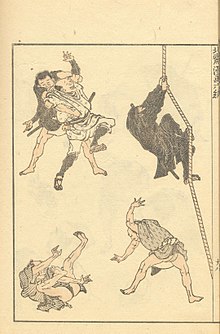Ninjutsu/History

In Japanese history, a ninja is a warrior specially trained in a variety of unorthodox arts of war. These include assassination, illusion, espionage, and various martial arts.
The exact origin of the ninja is a matter of debate. It is known that ninja appeared in 14th century Japan and remained active from the Kamakura to the Edo period. The role of the ninja may have included sabotage, espionage, scouting and assassination as a method of destabilization or to cause social chaos. Such actions may have taken place at the service of a feudal lord (daimyo, shogun), or other entity waging guerilla warfare.
Etymology
[edit | edit source]Ninja is the on'yomi reading of the two kanji 忍者 used to write shinobi-no-mono (忍の者), which is the native Japanese word for people who practice ninjutsu (忍術, sometimes transliterated as ninjitsu). The term shinobi (historically written with the Man'yōgana 志能備), has been traced as far back as the late 8th century to a poem Satake, Man'yōsh to Ōtomo no Yakamochi. The underlying connotation of shinobi means "to steal away" and—by extension—"to forbear", hence its association with stealth and invisibility. Mono (likewise pronounced sha or ja) means a "person."
The word ninja became popular in the post-World War II culture. The nin of ninjitsu is the same as that in ninja, whereas jitsu means skill or art, so ninjitsu means "the skill of going unperceived" or "the art of stealth"; hence, ninja and shinobi-no-mono (as well as shinobi) may be translated as "one skilled in the art of stealth." Similarly, the pre-war word ninjitsu-zukai means "one who uses the art of remaining unperceived."
Other terms which may be used include oniwaban (お庭番 "one in the garden"), suppa, rappa, mitsumono, kusa (草 grass) and Iga-mono ("one from Iga").
In English, the plural of ninja can be either unchanged as ninja, reflecting the Japanese language's lack of grammatical number, or the regular English plural ninjas.
The word "nin" contained in "ninja" and "ninjitsu", is a Chinese character (kanji) made up of the characters for blade/knife and heart/heart mind. The word takes on the meaning of patience, perseverance, endurance, and/or constancy depending on the translation. Originally the term "nin", had nothing to do with assassins or stealth, but it was used as a term to describe the spirit of some members of the Iga and Koga area clans who sought to protect their homes and way of life from daimyo and shogun who sought to acquire their territories. Samurai are known for following a strict code of morals, ethics, and codes as appointed by bushido, and a samurai who follows bushido is consider successful. Ninja no mono by contrast, set their codes based on the fulfillment/success of their goal or task as priority vs following rules. Samurai were interested in honor and reputation, while classically ninja no mono were known to prioritize the fulfillment of their task/job above all.
Period of origin
[edit | edit source]Ninja as a group first began to be written about in 14th century feudal Japan as martial organizations predominately in the regions of Iga and Koga of central Japan, though the practice of guerrilla warfare and undercover espionage operations goes back much further.
At this time, the conflicts between the clans of daimyo that controlled small regions of land had established guerrilla warfare and assassination as a valuable alternative to frontal assault. Since Bushidō, the samurai code, forbade such tactics as dishonorable, a daimyo could not expect his troops to perform the tasks required; thus, he had to buy or broker the assistance of ninja to perform selective strikes, espionage, assassination, and infiltrationof enemy strongholds.
There are a few people and groups of people regarded as having been potential ninja from approximately the same period. They are typically considered assassins. However, in his book Mystic Arts of the Ninja, Stephen K. Hayes depicts them in armor similar to a samurai. Hayes also says those who ended up recording the history of the ninja were typically those in positions of power in the military dictatorships. According to Hayes and Masaaki Hatsumi
Ninjitsu did not come into being as a specific well defined art in the first place, and many centuries passed before ninjitsu was established as an independent system of knowledge in its own right. Ninjitsu developed as a highly illegal counter culture to the ruling samurai elite, and for this reason alone, the origins of the art were shrouded by centuries of mystery, concealment, and deliberate confusion of history."
A similar account is given by Hayes: "The predecessors of Japan's ninja were so-called rebels favoring Buddhism who fled into the mountains near Kyoto as early as the 7th century A.D. to escape religious persecutionand death at the hands of imperial forces.
Historical organization
[edit | edit source]In their history, ninja groups were small and structured around families and villages, later developing a more martial hierarchy that was able to mesh more closely with samurai and the daimyo. These certain ninjitsu trained groups were set in these villages for protection against raiders and robbers.
Ninja museums in Japan declare women to have been ninja as well. A female ninja may be kunoichi (くノ一); the characters are derived from the strokes that make up the kanji for female (女). They were sometimes depicted as spies who learned the secrets of an enemy by seduction; though it's just as likely they were employed as household servants, putting them in a position to overhear potentially valuable information.
As a martial organization, it has been assumed that ninja would have had many rules, and keeping secret the ninja's clan and the daimyo who gave them their orders would have been one of the most important ones. For modern hierarchy in ninjitsu, see the article about ninjutsu.
